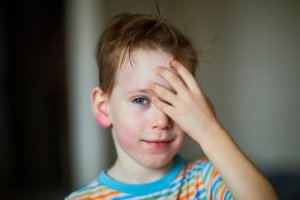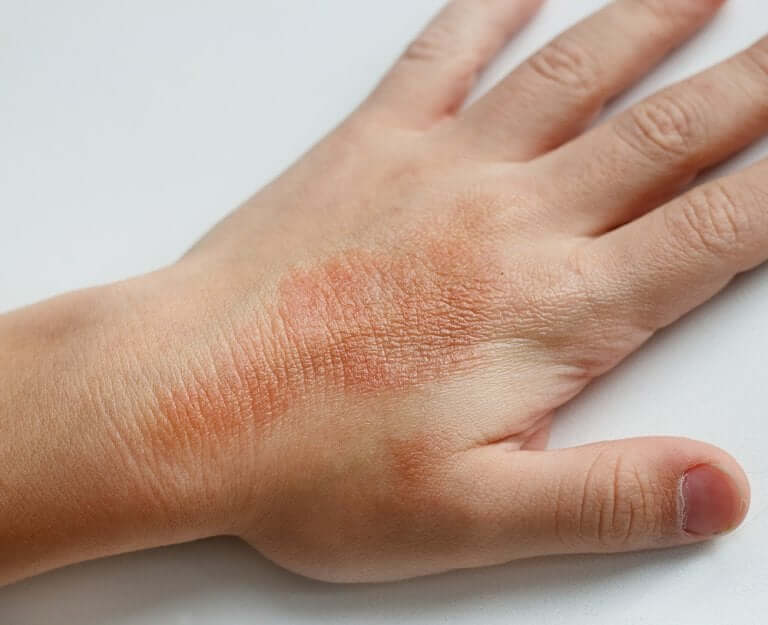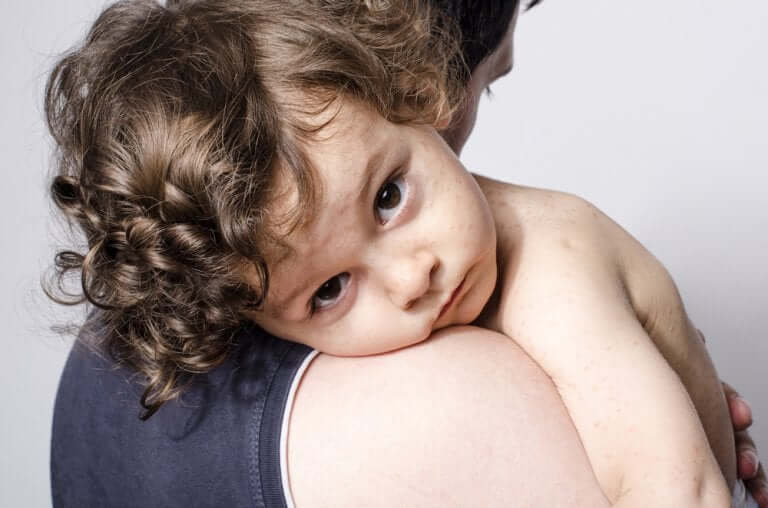What Is Juvenile Dermatomyositis?

Juvenile dermatomyositis is an inflammatory disease characterized by muscle weakness and skin lesions. At the onset of the disease, the child will begin to complain of difficulty in performing different daily activities or movements, such as climbing stairs, dressing, and even playing.
What is juvenile dermatomyositis?
According to research carried out by the Vicente López Municipal Hospital in Argentina, the incidence of dermatomyositis in pediatrics is between 1 and 3.2 per million children in the age range of 5 to 14 years. Doctors consider this to be a low percentage and an uncommon disease.
Juvenile dermatomyositis is a disease characterized by muscle inflammation and the appearance of a skin rash. As it’s a rare disease, its cause is unknown and, because of that, experts currently relate it to an autoimmune pathogenesis or genetic predisposition.
Symptoms of juvenile dermatomyositis
The symptoms of juvenile dermatomyositis are usually progressive. It begins with muscle weakness that starts to prevent the child from carrying out different types of activities. Then, skin lesions appear, which will help doctors to diagnose it more accurately.
Here are the symptoms in detail:
Muscle injury and weakness
Muscle weakness begins slowly, preventing simple activities such as climbing the stairs or getting dressed. Progressively, the child will begin to say that he or she is having difficulty performing everyday tasks.
In some cases, the child may even have painful muscle palpitations. Although these pains can occur anywhere in the body, they’re more frequent in proximal peripheral muscle groups.
Skin lesions
The child’s upper eyelids will often turn a purplish color. The official name for this is a heliotrope rash. Also, a photo localized erythema may occur on both cheeks. In the cervical-dorsal region, the so-called “shawl sign” may also appear.

Purple papules or plaque-type lesions may also appear on the hands. In addition, they’re usually accompanied by skin flaking, which is reminiscent of psoriasis. Gottron papules can appear on the fingers, and also on the elbows and knees.
Other symptoms
Although muscle aches and skin lesions are usually the most common complaints, other symptoms such as fever, tiredness, and weight loss are also common. Among other, less frequent, symptoms, we can find:
- Abdominal pain
- Digestive hemorrhage
- Pneumonia
- Pericarditis
- Myocarditis
- Symmetrical arthritis
- Microhematuria
- Behavioral disorders
- Hypertension
- Reynaud’s phenomenon (or syndrome)
Diagnosis
The diagnosis of this disease is determined by an analysis of the skin lesions, together with other findings from this process, such as muscle inflammation. Doctors will carry out a blood test, and they’ll expect to see high values in substances such as CPK, LDH or GOT. These are some of the tests that doctors may carry out:
- Blood tests. These will determine whether the child has high levels of muscle enzymes, such as creatine, kinase, and aldolase. Having high levels can, therefore, signify muscle damage.
- Electromyography. In this test, the doctor inserts a fine needle electrode through the skin into the muscle. Changes in the pattern of electrical activity will confirm if there is muscle disease.
- Skin or muscle biopsy. Doctors remove a piece of skin or muscle for lab tests. This will help determine if there are any muscle problems.
Treatment
During childhood, it’s essential to achieve a balance between rest, rehabilitation, and physiotherapy, in conjunction with medical treatment. This consists of the administration of steroids that, generally, must be maintained for long periods of time, sometimes even for a lifetime.
If the response to the treatment isn’t as expected or no improvement is seen, then doctors will then prescribe immunosuppressants (methotrexate and cyclosporine A). During this stage, rehabilitation and physical therapy will be essential.

Treatment for dermatomyositis is usually a long process, usually at least two years. However, in some cases, it can be even longer.
Diseases such as juvenile dermatomyositis can produce complications if the child doesn’t receive proper treatment and rehabilitation. Therefore, we recommend that parents see a pediatrician if they notice their child is having difficulty carrying out different basic tasks, and also if they notice some of the skin lesions that we’ve mentioned in this article.
Juvenile dermatomyositis is an inflammatory disease characterized by muscle weakness and skin lesions. At the onset of the disease, the child will begin to complain of difficulty in performing different daily activities or movements, such as climbing stairs, dressing, and even playing.
What is juvenile dermatomyositis?
According to research carried out by the Vicente López Municipal Hospital in Argentina, the incidence of dermatomyositis in pediatrics is between 1 and 3.2 per million children in the age range of 5 to 14 years. Doctors consider this to be a low percentage and an uncommon disease.
Juvenile dermatomyositis is a disease characterized by muscle inflammation and the appearance of a skin rash. As it’s a rare disease, its cause is unknown and, because of that, experts currently relate it to an autoimmune pathogenesis or genetic predisposition.
Symptoms of juvenile dermatomyositis
The symptoms of juvenile dermatomyositis are usually progressive. It begins with muscle weakness that starts to prevent the child from carrying out different types of activities. Then, skin lesions appear, which will help doctors to diagnose it more accurately.
Here are the symptoms in detail:
Muscle injury and weakness
Muscle weakness begins slowly, preventing simple activities such as climbing the stairs or getting dressed. Progressively, the child will begin to say that he or she is having difficulty performing everyday tasks.
In some cases, the child may even have painful muscle palpitations. Although these pains can occur anywhere in the body, they’re more frequent in proximal peripheral muscle groups.
Skin lesions
The child’s upper eyelids will often turn a purplish color. The official name for this is a heliotrope rash. Also, a photo localized erythema may occur on both cheeks. In the cervical-dorsal region, the so-called “shawl sign” may also appear.

Purple papules or plaque-type lesions may also appear on the hands. In addition, they’re usually accompanied by skin flaking, which is reminiscent of psoriasis. Gottron papules can appear on the fingers, and also on the elbows and knees.
Other symptoms
Although muscle aches and skin lesions are usually the most common complaints, other symptoms such as fever, tiredness, and weight loss are also common. Among other, less frequent, symptoms, we can find:
- Abdominal pain
- Digestive hemorrhage
- Pneumonia
- Pericarditis
- Myocarditis
- Symmetrical arthritis
- Microhematuria
- Behavioral disorders
- Hypertension
- Reynaud’s phenomenon (or syndrome)
Diagnosis
The diagnosis of this disease is determined by an analysis of the skin lesions, together with other findings from this process, such as muscle inflammation. Doctors will carry out a blood test, and they’ll expect to see high values in substances such as CPK, LDH or GOT. These are some of the tests that doctors may carry out:
- Blood tests. These will determine whether the child has high levels of muscle enzymes, such as creatine, kinase, and aldolase. Having high levels can, therefore, signify muscle damage.
- Electromyography. In this test, the doctor inserts a fine needle electrode through the skin into the muscle. Changes in the pattern of electrical activity will confirm if there is muscle disease.
- Skin or muscle biopsy. Doctors remove a piece of skin or muscle for lab tests. This will help determine if there are any muscle problems.
Treatment
During childhood, it’s essential to achieve a balance between rest, rehabilitation, and physiotherapy, in conjunction with medical treatment. This consists of the administration of steroids that, generally, must be maintained for long periods of time, sometimes even for a lifetime.
If the response to the treatment isn’t as expected or no improvement is seen, then doctors will then prescribe immunosuppressants (methotrexate and cyclosporine A). During this stage, rehabilitation and physical therapy will be essential.

Treatment for dermatomyositis is usually a long process, usually at least two years. However, in some cases, it can be even longer.
Diseases such as juvenile dermatomyositis can produce complications if the child doesn’t receive proper treatment and rehabilitation. Therefore, we recommend that parents see a pediatrician if they notice their child is having difficulty carrying out different basic tasks, and also if they notice some of the skin lesions that we’ve mentioned in this article.
All cited sources were thoroughly reviewed by our team to ensure their quality, reliability, currency, and validity. The bibliography of this article was considered reliable and of academic or scientific accuracy.
- Bosch, I. F. (2007). Conectivopatías: Dermatomiositis. AEPED [Internet], 18(4), 129-123.
- Moschini, M. B., Nabais Robalo, M. I., Raimondi, A., Bidegain, V., Melgarejo, M., & Pedre, J. (2011). Dermatomiositis. Archivos argentinos de pediatría, 109(3), 254-255. http://ref.scielo.org/p5f645
This text is provided for informational purposes only and does not replace consultation with a professional. If in doubt, consult your specialist.








